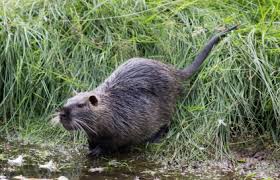The muskrat (Ondatra zibethicus) is a species of rodent in the subfamily of the voles. She is bred for fur under the name Bisam.
 The animal is between 25 and 40 centimeters long and has a strong, laterally flattened tail of 19 to 28 centimeter. It can be four times as heavy as the brown rat, about 1,700 grams.
The animal is between 25 and 40 centimeters long and has a strong, laterally flattened tail of 19 to 28 centimeter. It can be four times as heavy as the brown rat, about 1,700 grams.
The back is brown, the belly silver.
The hind legs are longer than the front legs, and are partially webbed. The forefoot is 25-30 mm wide and 30 mm long. The rear foot + 35 mm wide and 65 mm long. Both feet have five toes. It is a good swimmer and diver and she is active mainly at night and dusk.
A female can between April and November drop a nest every 28 days. They usually have one to three litters per year. After a gestation period of 25 to 30 days on average five to seven young are born.
They becom up to ten years in captivity, in the wild about three years.
The muskrat lives mainly from plants such as sedge and ponytails.
In winter he puts a burrow on grass and reeds. They do not hibernate.
She lives nearby static or flowing fresh water (rivers, lakes) with overgrown banks. In the banks, they dig a passage, whose entrance lies mostly below the surface. A second passageway is used for ventilation. The burrowing and pipes into levees are seen as a threat. Therefore, the muskrat is combatted.
They are caught with fykes, clamps and cage traps at the entrance of their house.
In Flanders, the animal is also called water rabbit. It is, therefore, a whole piece of meat that can be found on a variety of menu cards.
Any recipe as an example:
Cut the musk glands from the inside of the legs, remove all skin and fat. Let the meat for 2-3 hours in 1 tablespoon of salt in a quart of water to remove the blood. Drain well and dry.
Melt three tablespoons of butter in a casserole and fry the pieces muskrat brown.
Mix cream, vinegar, shallots, salt, pepper, herbs and butter.
Pour half of this mixture over the muskrat.
Cover the dish and let it simmer on a very low ebb.
